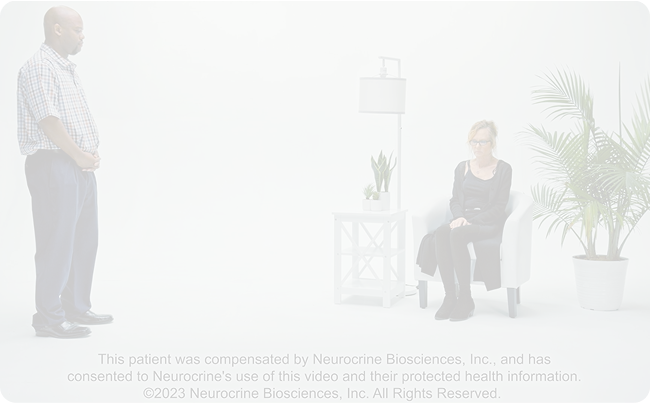

~4 mins
•Jan 2025
Digesting the DSM Lingo
In this quiz, clips from an Abnormal Involuntary Movement Scale (AIMS) exam will depict a real patient’s tardive dyskinesia (TD) symptoms. As the video plays, there will be an AIMS score sheet to fill out to practice scoring the severity of symptoms in each body region.
Upon completion, expert ratings and commentary will be available to view.
As the video plays, complete the first 7 questions on the AIMS score sheet. After submission, the quiz will automatically generate a value for the AIMS TD score, which is the sum of items 1 through 7.
After completion of the score sheet, along with ratings and commentary from TD experts. Remember that there is no “right” answer, but rather clinicians should strive to be as consistent as possible between patients and across clinical encounters.
The AIMS is a 12-item, clinician-rated scale used to assess symptom severity in patients with TD.1 The first 7 items score the severity of TD in various body regions on a scale from 0 (none) to 4 (severe). The body regions assessed by the AIMS include: facial and oral movements, extremity movements, and trunk movements.1 Importantly, TD is one of several drug-induced movement disorders and can present together with other movement disorders in the same patient.2 So, it is important to differentiate movements of TD from those of other disorders when rating movement severity on the AIMS. Ratings of tremor, which are not consistent with TD, are specifically excluded from the AIMS score.3 Similarly, steady muscular resistance (cogwheeling) associated with parkinsonism, standing fore-flexed posture of parkinsonism, or voluntary movements resulting from subjective restlessness and urge to move associated with akathisia should not contribute to the AIMS score.3
Experts agree that no specific score threshold suggests the need for intervention; instead, clinicians should consider the impact of the TD movements on the individual patient.4 Even one rating of mild severity (ie, ≥2 on the AIMS) could represent TD that may benefit from treatment.5 Click here for more on the AIMS.


References
Guy W. ECDEU Assessment Manual for Psychopharmacology: Revised. National Institute for Mental Health, Psychopharmacology Research Branch; 1976:534-537.
Hauser RA, Meyer JM, Factor SA, et al. Differentiating tardive dyskinesia: a video-based review of antipsychotic-induced movement disorders in clinical practice. CNS Spectr. 2022;27(2):208-217.
Menzies V, Farrell S. Schizophrenia, tardive dyskinesia, and the Abnormal Involuntary Movement Scale (AIMS). J Am Psychiatr Nurses Assoc. 2002;8:51-56.
American Psychiatric Association. The American Psychiatric Association Practice Guideline for the Treatment of Patients with Schizophrenia. American Psychiatric Association; 2021.
Caroff SN, Citrome L, Meyer J, et al. A modified Delphi consensus study of the screening, diagnosis, and treatment of tardive dyskinesia. J Clin Psychiatry. 2020;81(2):19cs12983.
Based on your answers, your AIMS dyskinesia total score is:
See expert ratings and commentary below:
Facial and Oral Movements
Extremity Movements
Trunk Movements
Clinical Professor of Psychiatry
University of California
San Diego, CA
Muscles of facial expression:
In the upper face I did note excessive blinking, but it was mild, so I rated item 1 as a 1.
Lips and perioral area, jaw, and tongue:
The movements in these body regions are prominent, moderate in severity, and seen throughout the exam, especially during distraction. For this reason I rated items 2, 3, and 4 with scores of 3.
Upper extremities, lower extremities, and neck, shoulders, and hips:
I did not see any movements in the upper or lower extremities or in the neck, shoulders, or hips, so items 5, 6, and 7 were all rated a 0.
Professor of Neurology
University of South Florida
Director, Parkinson’s Disease and Movement Disorders Center
Tampa, FL
Muscles of facial expression:
I did not see any abnormal movements in the upper half of the patient’s face, so I rated item 1 a 0.
Lips and perioral area:
The patient has abnormal movements in the lips and perioral region. These are mostly mild in amplitude and occur during most of the exam, hence I rated them a 2. There is one burst of moderate amplitude perioral movements during finger tapping, but this only occurs during some of the exam, so my rating would still be a 2 for this item.
Jaw:
The patient has lateral jaw movements that are mostly mild in amplitude and present during most of the exam, hence I rated this item a 2.
Tongue:
In this patient’s case, her most severe tongue movements occur when the tongue is inside her mouth. I would describe these as moderate due to the excursion of the tongue to the sides and roof of the mouth. I don’t feel they are severe as the tongue doesn’t protrude beyond the lips and the intensity of the movements is not great. The movements are present during most of the time that her mouth is open, and I therefore rated them a 3.
Upper extremities:
The patient has low amplitude movements in the arms when we are observing her hands at rest in her lap. We don’t see these elsewhere in the video, so since they are low amplitude and not present during most of the exam, I think these are best rated as a 1.
Lower extremities:
While observing her hands resting in her lap, she has some adduction movements in her legs. These are low amplitude and not observed elsewhere in the video, so I rated them a 1.
Neck, shoulders, and hips:
I did not see abnormal movements in these areas, so I rated this item a 0. At one point in the video, her left shoulder appears elevated, and at another point her right shoulder appears elevated. However, I was not convinced that these represented abnormal movements because there were no other signs of dystonic posturing in this body region, such as a turned or tilted head or neck.
A limitation of practicing AIMS rating using short video clips is that we skip around in the examination of body parts. During an actual examination, one should take an orderly approach.
Note that the ratings should capture both the amplitude and persistence of the abnormal movement. For example, a moderate-amplitude movement that is only present during some of the exam may be a 2, whereas a moderate-amplitude movement that is present during most of the exam may be a 3. Keep in MIND that in this short video, there may not be as much information available about the persistence of the patients’ abnormal movements when compared to full-length exams.
A lot of times, when performing the AIMS exam, I can narrow down the potential rating to 2 possible scores. Then, through careful observation, I can decide which of those 2 possible scores best captures the amplitude and persistence of the abnormal movement. Being consistent from exam to exam and from patient to patient is key.
The AIMS provides a standardized scoring system to evaluate and follow changes in the abnormal movements of tardive dyskinesia. Remember, however, that the AIMS score is only part of the picture; one must also assess the social, emotional, and functional impacts of the abnormal movements to assess their full impact.